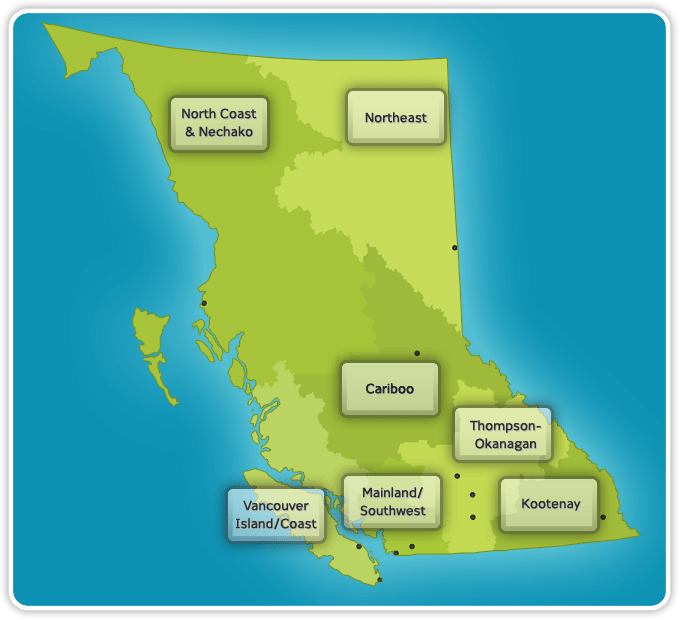|
A New Direction for the Economy
No to the Kinder Morgan Pipeline
Expansion!
A New Direction
for the Economy
• No to the Kinder Morgan Pipeline Expansion!
• Time to Reverse Damage Caused by
Clark/Campbell Government's
2003 Attack on Appurtenancy
A Matter of Right
• Preventable Seniors' Homes Fires and Deaths
For Your Information
• Regional Statistics for BC - Work
BC
A New Direction for the Economy
No to the Kinder Morgan Pipeline Expansion!
The oil monopolies and big
banks with which they are merged, the think tanks of the rich, and the
Harper, Clark and Redford governments have carried
out a huge PR campaign to try and convince the people of BC and Alberta
that exporting bitumen from the oil sands is the road to prosperity. It
seems that,
according to the rich, the biggest problem facing Canada is the lack of
pipeline capacity to export bitumen and that the job of governments is
to act as
salespeople for the pipeline monopolies Kinder Morgan, Enbridge and
Trans Canada.
Christy Clark and the BC Liberals are trying to rescue
themselves by claiming that they are the ones who can be counted on to
"manage the economy"
and that opposition to the Kinder Morgan pipeline is bad for the
economy. NDP leader Adrian Dix recently announced that the NDP "does
not support a
radical transformation of the ports of Metro Vancouver into major oil
export facilities." Dix pointed out, "The revised Kinder Morgan
proposal would
significantly increase tanker traffic passing by Stanley Park."
The private interests of Kinder Morgan and the mainly
foreign oil companies that dominate the oil sands cannot be equated
with the public interest. Facts
show that building pipelines to export bitumen does not solve any
problem of the economy. They provide a means for the mainly
foreign-owned oil
monopolies, which dominate the tar sands, to enrich themselves but do
not lead to the building of a vibrant self-reliant diverse economy
based on
manufacturing and stable public services. Even existing refining
capacity is threatened.
Why the Kinder Morgan Pipeline Is Bad for the BC Economy
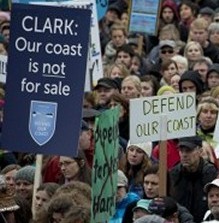 The Kinder Morgan Pipeline
runs from Edmonton to the
Westridge marine
terminal in Burnaby. It was built in 1953 as the Trans-Mountain
Pipeline. Kinder Morgan bought the pipeline in 2005 and has
increasingly been using it
to carry diluted bitumen from the tar sands. Kinder Morgan is proposing
to twin the existing line, increasing capacity from 300,000 to 750,000
barrels a
day. The Kinder Morgan Pipeline
runs from Edmonton to the
Westridge marine
terminal in Burnaby. It was built in 1953 as the Trans-Mountain
Pipeline. Kinder Morgan bought the pipeline in 2005 and has
increasingly been using it
to carry diluted bitumen from the tar sands. Kinder Morgan is proposing
to twin the existing line, increasing capacity from 300,000 to 750,000
barrels a
day.
Operation of the pipeline involves only 35 permanent
jobs. Kinder Morgan's track record makes an oil spill a very real
concern, and a spill would put
many other industries at risk. The Communications, Energy and
Paperworkers' Union (CEP) has raised another concern that the pipeline
expansion would
make BC even more dependent on imported gasoline and refined products.
Vancouver used to have four refineries. Only one is left, the Chevron
refinery, which produces about 55,000 barrels a day of gasoline, jet
fuel, diesel
fuel and other products and where there are 400 jobs at stake. The
Chevron refinery
is supplied by the Trans-Mountain pipeline.
Since Kinder Morgan acquired the pipeline, it has
increased the amount of oil shipped by tanker to the U.S. and Asia from
22 to over 60 tankers a year.
CEP reports that the Chevron refinery may have to scale back production
because it cannot secure enough oil to maintain current production
because of these
increased exports. According to Kinder Morgan's data, in 2010 only 25
per cent of the oil shipped in the Trans-Mountain system was refined
for use in the
Lower Mainland. Four per cent remained in Kamloops, 44 per cent was
shipped to Washington State via pipeline, and 27 per cent was loaded
onto tankers
for shipment to the U.S. and Asia.
With the expansion, Kinder Morgan plans to increase
marine exports to close to 80 per cent of the total pipeline capacity.
Most or all of this would be
diluted bitumen from the Alberta oil sands. Export of bitumen deprives
Canada of value-added jobs in upgrading, refining and the associated
petrochemical
industry, threatens existing refining and increases Canada's irrational
coast to coast dependency on expensive imported petroleum products.
Tanker Traffic in Vancouver Harbour
If expansion of the Kinder
Morgan pipeline were approved, the terminal in Burnaby would be
expanded from one berth to three to handle 400 tankers annually up from
the current traffic of 60. The Aframax tankers proposed to serve the
pipeline are
approximately 245 metres long and have a capacity of 879,000 barrels.
At this
time, they are not usually fully loaded because of draft restrictions.
Kinder Morgan
is proposing to dredge under the Ironworkers Memorial Bridge to allow
even larger Suezmax tankers access to the terminal. Suezmax tankers are
275 metres
long and have a capacity of 1,759,200 barrels.
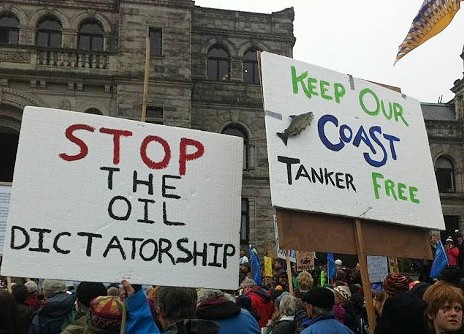 Bitumen spills pose
different problems than conventional
oil. This means that more and possibly different methods of remediation
are required should
a spill occur, particularly once bitumen sinks into the water column or
soil. During the hearings into the Northern Gateway Pipeline, it
became clear
that Enbridge had not submitted plans for clean-up based on a bitumen
spill, but only for a spill of conventional oil. There is no reason to
believe it will
be any different when Kinder Morgan submits its application. Efforts by
the leading Canadian scientist in the field to conduct the necessary
research on this
problem have been blocked by the Harper government. Bitumen spills pose
different problems than conventional
oil. This means that more and possibly different methods of remediation
are required should
a spill occur, particularly once bitumen sinks into the water column or
soil. During the hearings into the Northern Gateway Pipeline, it
became clear
that Enbridge had not submitted plans for clean-up based on a bitumen
spill, but only for a spill of conventional oil. There is no reason to
believe it will
be any different when Kinder Morgan submits its application. Efforts by
the leading Canadian scientist in the field to conduct the necessary
research on this
problem have been blocked by the Harper government.
The Harper and Clark governments have put up roadblocks
to the people, including the First Nations, to discuss in a rational
manner these matters that
are of great concern, particularly to deliberate on the direction of
the economy. The considerations of private monopoly interests such as
Kinder Morgan
and Enbridge are very self-serving and narrow. Environmental
destruction and harm to peoples' health are considered collateral
damage. These monopolies
and those who own and control them do not take into account the effects
of such development on the broader economy, such as the necessity of
manufacturing and investing in a vibrant stable public service sector
and social programs, as their focus is narrowly on the return on their
own particular
capital and quarterly reports of their companies. These monopolies such
as Kinder Morgan and Enbridge cannot be left to themselves to decide;
they must
come under the restrictions of government. The record of the
Clark/Campbell Liberal government on serving private monopoly interests
and not the people is an open book. Those who oppose the expansion of
the Kinder Morgan Pipeline must work hard to make sure the Liberals are
not returned to power on May 14. This is a good place to start to
provide a new direction for the economy.
For Your Information
Kinder Morgan
Kinder Morgan is a U.S. energy monopoly formed in 1997
when a pair of former high-level Enron
executives, Richard Kinder and William Morgan, bought pipelines and
other assets from Enron. In the last 16 years, Kinder Morgan has
amassed huge assets,
describing itself as the third largest energy company in North America.
It reports private ownership of 80,000 miles of pipelines, 180
terminals and two
producing oil fields in Texas. It operates as four companies with a
combined market value on stock exchanges of $115 billion. Kinder Morgan
purchased
the Trans-Mountain pipeline system in 2005.
Kinder Morgan has accrued a significant number of spills
in its 16 years of operation, including four along the Trans-Mountain
since 2005. Kinder
Morgan's track record has been described as one of pollution,
law-breaking and cover-ups. Kinder Morgan has been fined by the U.S.
government for stealing
coal from customer stockpiles, lying to air pollution regulators,
illegally mixing hazardous waste into gasoline and the illegal dumping
of
chemicals to avoid
landfill charges. It has also been found guilty of numerous labour
violations including failure to pay overtime and repeated workplace
safety violations.
CEO William Kinder was a major financier of George W.
Bush's two presidential election campaigns and donor to Republican
candidates and
committees.

Time to Reverse Damage Caused by Clark/Campbell
Government's 2003 Attack on Appurtenancy
In the late 1990s, powerful
monopoly interests in the forestry sector began to campaign against
forest regulations, which had existed in one form or
another for over a hundred years. These regulations, specifically the
concept of appurtenancy, required a company that harvested trees from
BC forests to
maintain nearby mills to process the logs.
The forest monopolies, especially those with mills
elsewhere in Canada or the U.S., demanded the right to cut, mill and
ship the logs in whatever way
served their narrow private interests without restrictions even if this
meant closing local mills and damaging BC forest communities.
Responding to the
demand of the private interests of the forest monopolies the Campbell
anti-social Liberal government introduced its Forestry
Revitalization Plan in March 2003.
The Liberal government plan made the
regulatory changes demanded by the forest monopolies, which wiped out
the requirements for
appurtenancy. This resulted in a jump in the export of trees harvested
in BC as raw logs either to the U.S. or Asia. The regulatory changes
became one more
factor in the cascading economic and natural crises in the sector,
which tumbled one after another leading to mass layoffs and the
bankruptcy closure or sale
of many sawmills and pulp mills. The upheaval precipitated further
consolidation and concentration of ownership of the forest industry in
the hands of large
monopolies, which have unprecedented power to dictate the direction of
the economy to serve their private interests.
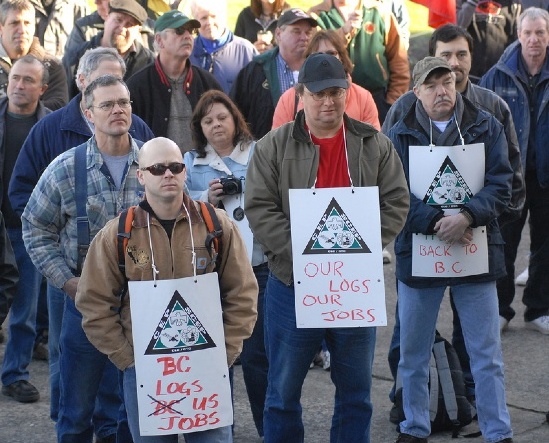 The changes brought in with
the Forestry
Revitalization Plan affected the following arrangements, which had
been in place for some time.
The description of the regulatory target of the Revitalization Plan
comes from the anti-social Liberal government itself. The changes brought in with
the Forestry
Revitalization Plan affected the following arrangements, which had
been in place for some time.
The description of the regulatory target of the Revitalization Plan
comes from the anti-social Liberal government itself.
The plan states: "In exchange for the right
to log portions of BC's public forest lands, the Forest Act requires
licensees to abide by various existing regulations.
Historically, these included an obligation to log a certain minimum
level of timber each year; requirements to process that timber at
certain mills (known
as appurtenancy) or, more generally, in mills owned by the licensee
(known as timber processing requirements); and penalties for
transferring any part of
a tenure, in addition to restrictions on subdividing tenure licences."
Forest workers and their communities did not have a say
or control over the changes brought in by the Forestry
Revitalization Plan, which
eliminated the regulations described above. No profound discussion took
place as to the consequences of such changes in the lives of forest
workers, their
communities and the forest economy. Any discussion in the mass media
prior to the changes was simply to disinform public opinion.
Spokespeople and
economic experts of the most powerful monopolies, their political
representatives in the Liberal government and mass media dominated talk
around the
proposed changes and did not allow any opposition or alternative
proposals to develop. When problems or misgivings about possible bad
consequences were
pointed out, these problems were dismissed as
necessary hardship to revitalize the sector.
 The Liberal government
quickly pushed through its
neo-liberal forestry agenda with support from the mass media. This
onslaught did not allow an
opposition of workers, small business and community members to form or
develop a pro-social alternative that would modernize the forest
industry in ways
that served the working class, the forest communities and local
businesses in a sustainable self-reliant way. The people, in particular
the forestry working
class, lacked a vibrant organized independent political voice that
could confront monopoly right and defeat it. The Liberal government
quickly pushed through its
neo-liberal forestry agenda with support from the mass media. This
onslaught did not allow an
opposition of workers, small business and community members to form or
develop a pro-social alternative that would modernize the forest
industry in ways
that served the working class, the forest communities and local
businesses in a sustainable self-reliant way. The people, in particular
the forestry working
class, lacked a vibrant organized independent political voice that
could confront monopoly right and defeat it.
Monopoly right and its political representatives in the
anti-social Liberal government effectively marginalized and victimized
the actual producers and
forest communities with these changes over which the people exercised
no control. The Clark/Campbell anti-social Liberal government acted as
political
representatives of the most powerful, privileged private interests and
did their bidding. This must cease! It is time for an alternative! The
people must be
in control of their destiny, which importantly includes their
livelihoods and the direction of their economy and the political
affairs of their industry,
communities, province and country. Changing the direction of the
economy in BC begins with defeating the Liberals on May 14.

A Matter of Right
Preventable Seniors' Homes Fires and Deaths
In the early morning on April 3, an 80-year-old
senior,
died when his residence, The Elms, a seniors' complex in Langley, BC
caught
fire. A number
of other seniors were injured and hospitalized. The thirty-year-old
structure was not legally bound to provide a sprinkler system, and did
not have one. Martha
Jane Lewis, executive director of the BC Centre for Elder Advocacy
Support told media, "the government must be involved [because private
owners] are
not going to go the extra mile. It's costly to install sprinklers." A
change to the BC Building Code in 1992 in BC made sprinklers mandatory
in
residential
buildings four storeys or higher or in any building classified as a
care facility. But older buildings are exempt from installing them
unless they undergo major
renovations.
In January 2013, the Ontario government promised to
invest $20 million to install sprinklers in some of the thousands of
senior care facilities in that
province that do not presently have them. A major BC study, Sprinkler
Systems
and
Residential
Structure
Fires,
Exploring
the
Impact of
Sprinklers for
Life Safety and Fire Spread, written by Fire Chief Len Garis and
Dr. Joseph Clare was published in January 2013 by the School of
Criminology and
Criminal Justice at Simon Fraser University.[1]
In this well-researched document one table says it all:
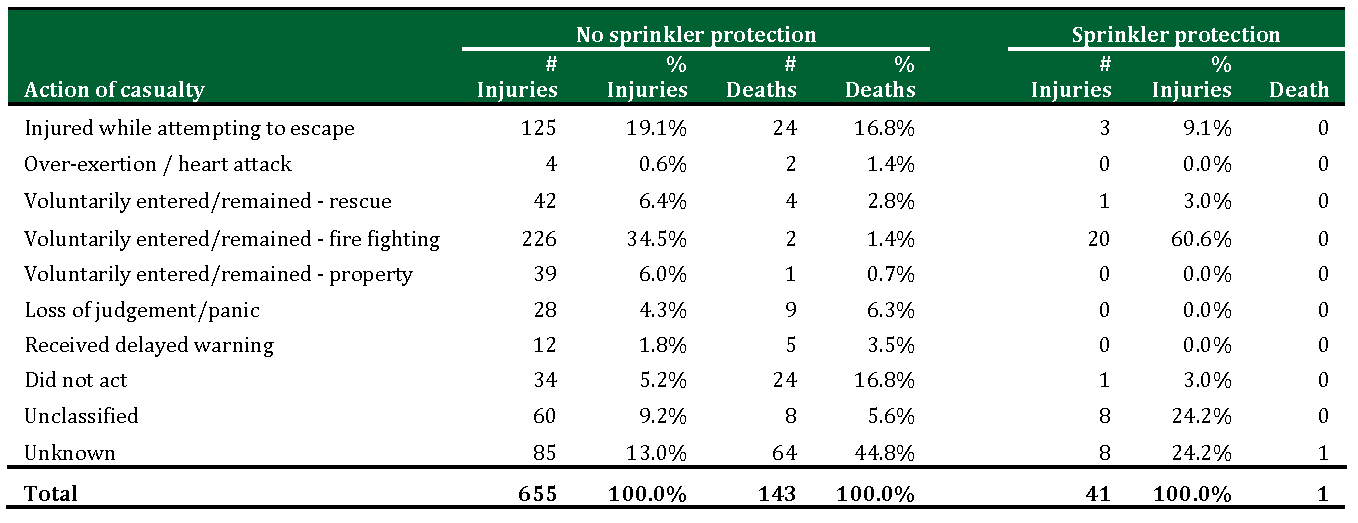 Click on image to
enlarge.
Click on image to
enlarge.
The statistics reveal the enormous importance of
ensuring apartment buildings, and most certainly senior care
facilities, be equipped with sprinkler
systems:
"Overall, 8.7% of fires at residential properties
occurred in buildings with complete sprinkler protection.
"94.1% of injuries and 99.3% of deaths overall occurred
in properties that did not have sprinkler protection.
"Over one-third (36.6%) of fires in apartments occurred
in sprinkler protected buildings. 95.0% of the deaths and 85.1% of the
injuries in apartment
buildings occurred without sprinkler protection.
"Less than one percent (0.9%) of the fires in single
detached residential buildings occurred in the presence of sprinkler
protection. All of the deaths and
99.4% of the injuries that occurred in these single detached structures
occurred in the absence of sprinklers."
After the tragedy on April 3, co-author of the study
Fire Chief Garis of
Surrey, told a CBC noon-hour radio show
that without question it is
a social responsibility to provide seniors' homes with sprinklers. He
underlined that they are life-savers and prevent horrible burns and
smoke inhalation damage
to seniors and save valuable care facility structures that are in short
supply in BC. However, when the CBC interviewed Mayor Peter Fassbender
of Langley
City, who is now running as the Liberal candidate in Surrey-Fleetwood
riding, he said that installing sprinklers would be so expensive
for
privately-owned facilities as to make the residential fees too high for
the seniors. He said it was the policy objective of the Liberals to
ensure sprinklers were
installed, but he had no specific program to do so. Indeed, he
reiterated several times that cost was the main obstacle to protecting
seniors from
devastating fires such
as the one that destroyed The Elms in Langley and killed the
80-year-old resident.
Fassbender is an advocate of "austerity," part of the
neo-liberal agenda of Christy Clark. For him and his political ilk,
it's all about cost, not about the
lives and well-being of vulnerable seniors living in residences without
sprinkler systems, nor about preserving the structures in such short
supply throughout
the province.
On May 14, the polity in BC, most especially workers,
youth and students, and seniors must get out and vote to throw out
those who put "costs" before
lives, those who shamelessly promote the delivery of services where a
"bottom line" determines everything. Safe and quality seniors'
residences are a social
requirement to guarantee the rights of seniors in BC to a dignified old
age.
No self-serving excuses and no empty policy objectives are acceptable!
The people
demand action!
Note
1. For
full report click
here.

For Your Information
Regional Statistics for BC
- Work BC -
British Columbia's development regions are: Vancouver
Island/Coast, Mainland/Southwest, Thompson-Okanagan, Kootenay, Cariboo,
North Coast & Nechako, and Northeast.
Each development region is made up of a number of
regional districts. There are 29 regional districts in the province.
Population Distribution
Most of B.C.'s population is located in the southwestern
corner of
the province. In 2008, the proportion of the population, by region, was:
Mainland/Southwest -- 60%
Vancouver Island/Coast --17%
Thompson-Okanagan -- 12%
Cariboo -- 4%
Kootenay -- 3%
North Coast & Nechako -- 2%
Northeast -- 2%
About 88% of British Columbians live in urban areas --
cities, towns,
villages and other incorporated districts. The remaining 12% live
in rural (unincorporated) areas, some close to urban centres and some
in more remote areas.
Mainland/Southwest is the most highly urbanized region:
only 2% of
its residents live in rural areas. By contrast, about 43% of residents
in North Coast
& Nechako live in rural areas, as do 36% in both Northeast and
Cariboo, and 20% in both Thompson-Okanagan and Vancouver Island/Coast.
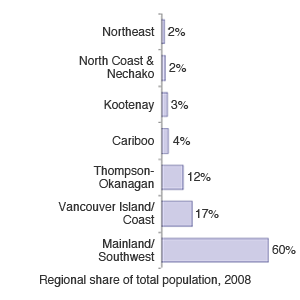 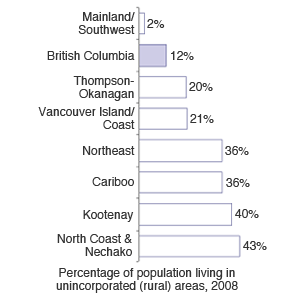
Seventy-seven
per
cent
of
British
Columbians live in the southwestern corner of the
province (left). About 88% of British Columbians live in
urban
(incorporated) areas (right).
Population Age Distribution
The population is aging
|
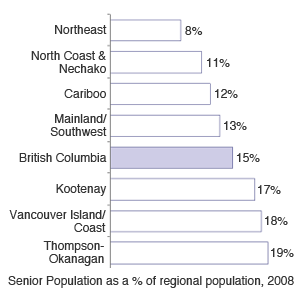 Nineteen
per
cent
of
population
in
Thompson-Okanagan is 65 years and older, compared with 15% for B.C. as
a whole Nineteen
per
cent
of
population
in
Thompson-Okanagan is 65 years and older, compared with 15% for B.C. as
a whole
|
B.C.'s population is aging. In 2006, for the first time
since census-taking started in the province, the median
age in B.C. was just over 40 years.
Between 1995 (the first year for which regional
workforce data is
available) and 2008, the number of seniors -- people aged 65 and older
--
grew by 34%. That was more than double the increase in B.C.'s total
population during the same period (16%).
In 2008, 15% of the population of the province was aged
65 and
older. By comparison, 19% of the Thompson-Okanagan population was in
this age
category. Seniors accounted for the smallest percentage of the total
population in Northeast (8%) and North Coast & Nechako (11%).
Changes in the size and age structure of the
population are
linked to changes in employment over time. For example, because many
people
65 years or older are retired, a large senior population in a region
will mean that a smaller share of its residents is likely to be
available for work.
Northern regions of the province have a more youthful
population than other regions
Between 1995 and 2008, the number of children (under 15
years)
living in B.C. decreased by 8% while the province's total population
grew by 16%.
Mainland/Southwest, where the population grew by 23%, is
the only
region that saw an increase in children (3%) from 1995 to 2008.
Overall, the northern regions have a youthful population
compared
with other regions of the province, but even in the north the number of
children is
declining. In North Coast & Nechako, for example, children made up
20% of the population in 2008. Yet, between 1995 and 2008, the number
of young
people there declined by a greater proportion than in any other region
(34%). North Coast & Nechako's total population shrank by 14% in
the same
period.
In 2008, Cariboo also had a relatively large number of
children
(18%), as did Mainland/Southwest (16%). Thompson-Okanagan (15%) and
Vancouver
Island/Coast (14%) had proportionally fewer children.
In every region, at least two-thirds of the
population is between 15 and 64 years of age.
The largest share of the population in every region is
of working
age; that is, between 15 and 64 years. In 2008, the largest percentages
of working-aged
residents were in Mainland/Southwest (71%) and Cariboo (70%).
Proportionally smaller working-aged populations were in
Thompson-Okanagan (66%) and
Kootenay (67 per cent), both having large senior populations.
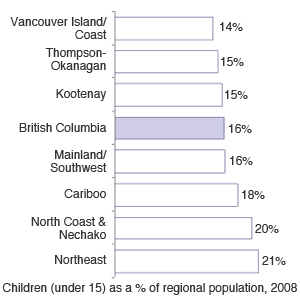 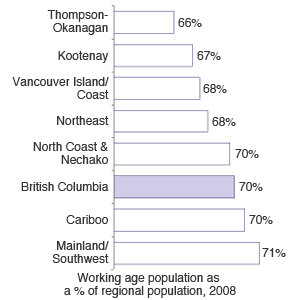 Twenty
per cent of the population in Northeast and in
North Coast & Nechako is under 15 (left). Relative
to
its
population
overall,
Mainland/
Southwest
has the largest number of working-aged residents of any region in
B.C. (right)
Twenty
per cent of the population in Northeast and in
North Coast & Nechako is under 15 (left). Relative
to
its
population
overall,
Mainland/
Southwest
has the largest number of working-aged residents of any region in
B.C. (right)
Workforce
In 2008, the number of working-aged women (1,530,600) in
B.C. was slightly higher than the number of working-aged men
(1,528,500).
However, women made up slightly less of the workforce (47 per cent)
than men did.
Among regions, women made up the largest share of the
total
workforce in Vancouver Island/Coast (49 %) and North Coast &
Nechako (48%). In
Northeast, where men outnumbered women, the percentage of the workforce
that is female was lower (43%).
Women
make
up
47%
of
B.C.'s workforce (left). Eighty per cent of workers in
B.C. have full-time jobs (right)
In 2008, 80% of people working in B.C. had
full-time jobs
(meaning they usually spent at least 30 hours a week on the job).
Full-time work
was most common in Northeast (83%) and Mainland/Southwest (81%), and
least common in Kootenay (77%).
Although Kootenay had fewer full-time workers
than any
other region in 2008, it had proportionally more self-employed workers
(23%) -- well above the average for B.C. as a whole (18%).
Self-employment is
much less common in North Coast & Nechako, where 13% of workers are
self-employed.
Over the past two decades, unemployment rates
have
generally been lowest in Northeast and Mainland/Southwest and highest
in Cariboo
and North Coast & Nechako. While B.C.'s unemployment rate averaged
7.2% between 1995 and 2008, the rate in these regions averaged:
Northeast -- 5.7%, Mainland/Southwest -- 6.6%, Cariboo -- 9.4%, North
Coast & Nechako -- 9.3%.
The self-employment rate is highest in
Kootenay and
lowest in North Coast & Nechako (left). Northeast and
Mainland/Southwest typically have the
lowest unemployment rates in B.C. (right)
Regional Economies
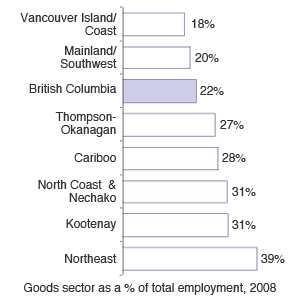
Regions with a large rural population are
most dependent
on the goods sector as a source of employment
|
The regions' economies are as varied as their
geographies and populations. In more rural areas, goods-producing
industries play a larger role
than they do in more urban areas.
The goods sector employs the largest share of the
workforce in
Northeast (39%), Kootenay (31%) and North Coast & Nechako (31%) --
all regions
with a relatively large rural population.
The most highly urban regions are the least dependent on
goods
production as a source of employment. These are Vancouver Island/Coast
(18% share
of the workforce) and Mainland/Southwest (20%).
Vancouver
Island/Coast Region
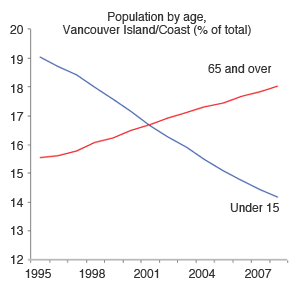 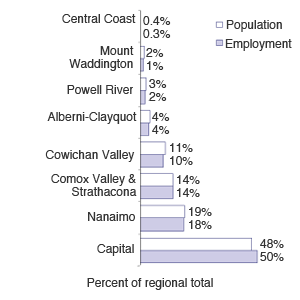 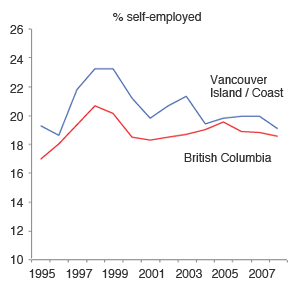 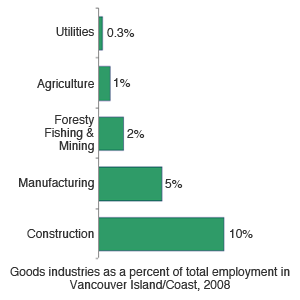
Mainland /Southwest
Kootenay
Cariboo
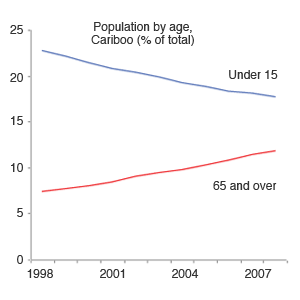 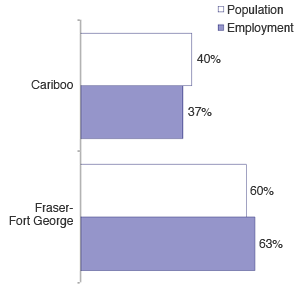
North Coast and Nechako

PREVIOUS
ISSUES | HOME
Read BC Worker
Website: www.cpcml.ca
Email: office@cpcml.ca
|

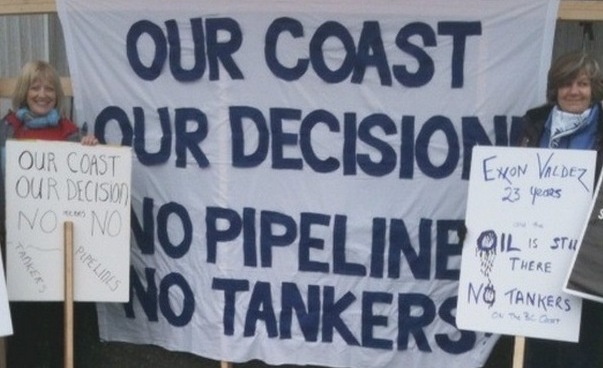
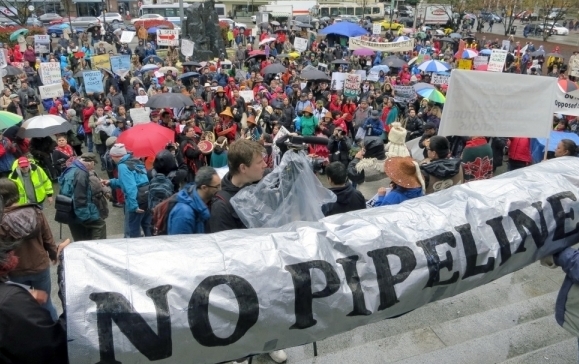
 Nineteen
per
cent
of
population
in
Thompson-Okanagan is 65 years and older, compared with 15% for B.C. as
a whole
Nineteen
per
cent
of
population
in
Thompson-Okanagan is 65 years and older, compared with 15% for B.C. as
a whole

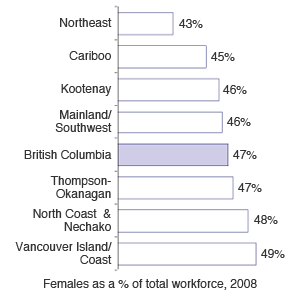
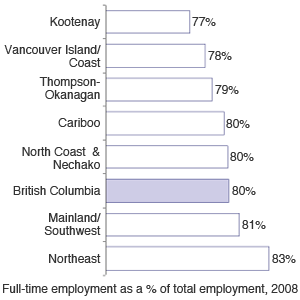
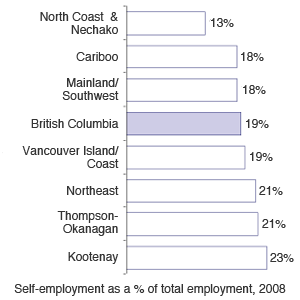
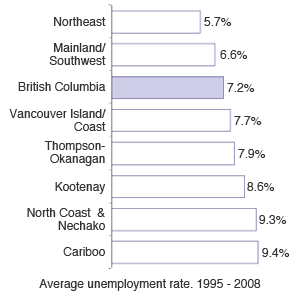





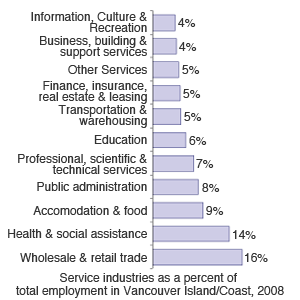
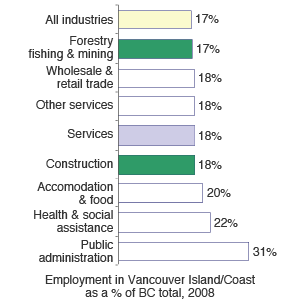
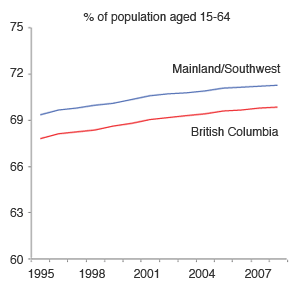
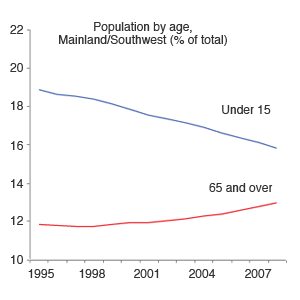
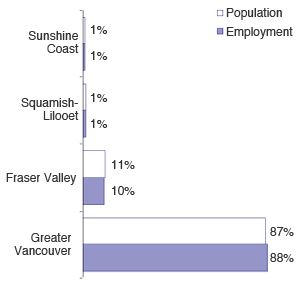
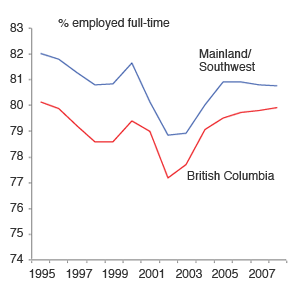

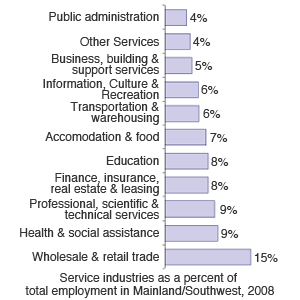
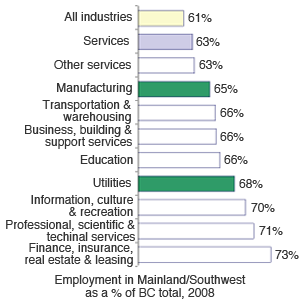

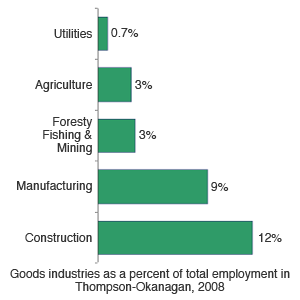
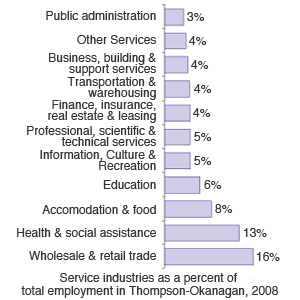
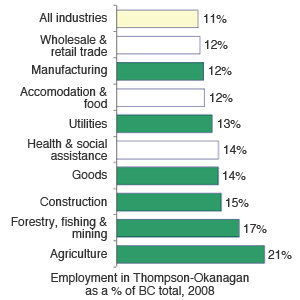

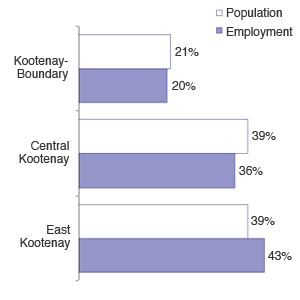
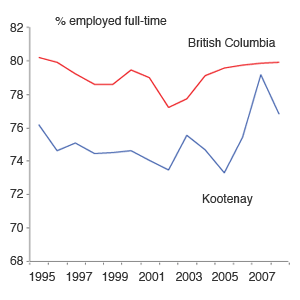
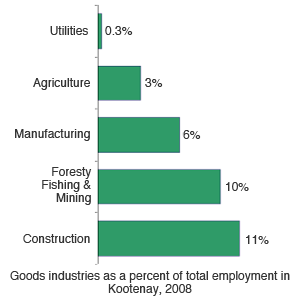
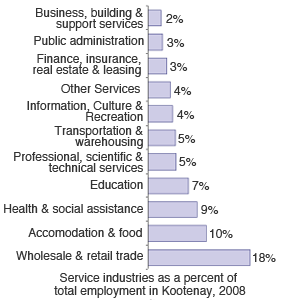



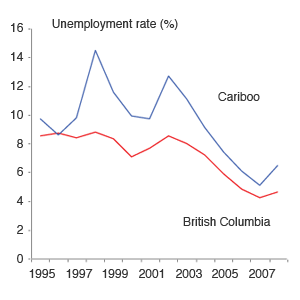
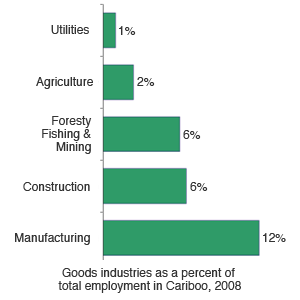
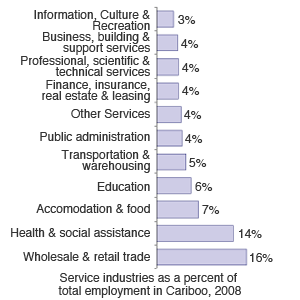

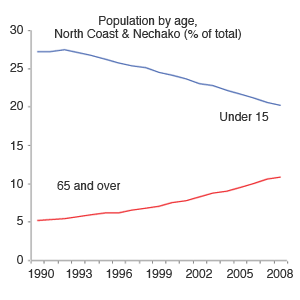
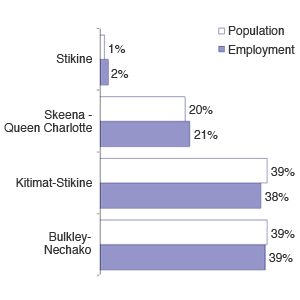
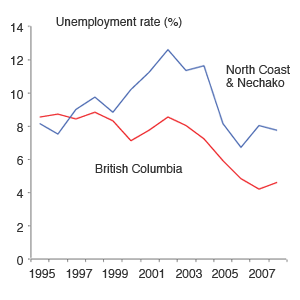
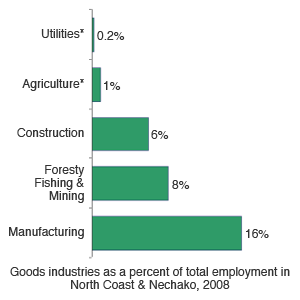
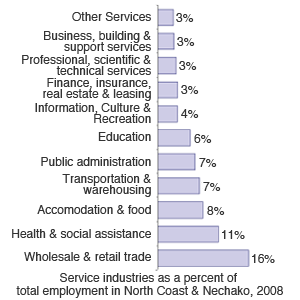
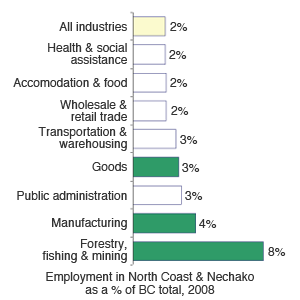
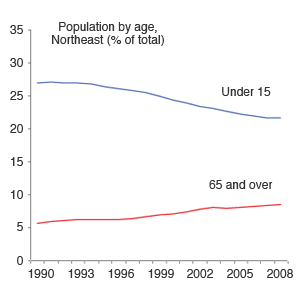
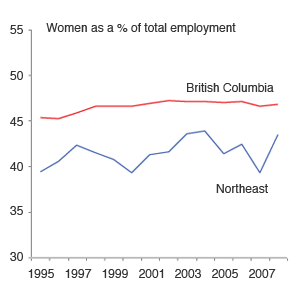
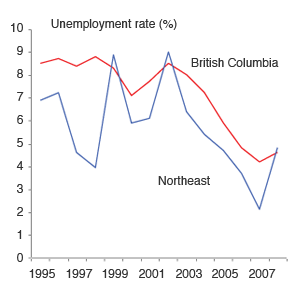
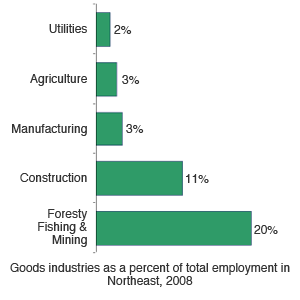
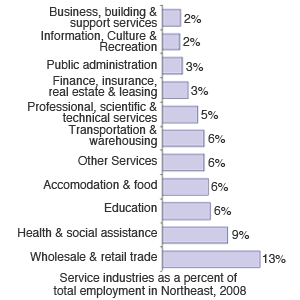
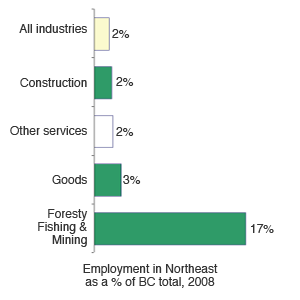
 The Kinder Morgan Pipeline
runs from Edmonton to the
Westridge marine
terminal in Burnaby. It was built in 1953 as the Trans-Mountain
Pipeline. Kinder Morgan bought the pipeline in 2005 and has
increasingly been using it
to carry diluted bitumen from the tar sands. Kinder Morgan is proposing
to twin the existing line, increasing capacity from 300,000 to 750,000
barrels a
day.
The Kinder Morgan Pipeline
runs from Edmonton to the
Westridge marine
terminal in Burnaby. It was built in 1953 as the Trans-Mountain
Pipeline. Kinder Morgan bought the pipeline in 2005 and has
increasingly been using it
to carry diluted bitumen from the tar sands. Kinder Morgan is proposing
to twin the existing line, increasing capacity from 300,000 to 750,000
barrels a
day. Bitumen spills pose
different problems than conventional
oil. This means that more and possibly different methods of remediation
are required should
a spill occur, particularly once bitumen sinks into the water column or
soil. During the hearings into the Northern Gateway Pipeline, it
became clear
that Enbridge had not submitted plans for clean-up based on a bitumen
spill, but only for a spill of conventional oil. There is no reason to
believe it will
be any different when Kinder Morgan submits its application. Efforts by
the leading Canadian scientist in the field to conduct the necessary
research on this
problem have been blocked by the Harper government.
Bitumen spills pose
different problems than conventional
oil. This means that more and possibly different methods of remediation
are required should
a spill occur, particularly once bitumen sinks into the water column or
soil. During the hearings into the Northern Gateway Pipeline, it
became clear
that Enbridge had not submitted plans for clean-up based on a bitumen
spill, but only for a spill of conventional oil. There is no reason to
believe it will
be any different when Kinder Morgan submits its application. Efforts by
the leading Canadian scientist in the field to conduct the necessary
research on this
problem have been blocked by the Harper government.

 The changes brought in with
the Forestry
Revitalization Plan affected the following arrangements, which had
been in place for some time.
The description of the regulatory target of the Revitalization Plan
comes from the anti-social Liberal government itself.
The changes brought in with
the Forestry
Revitalization Plan affected the following arrangements, which had
been in place for some time.
The description of the regulatory target of the Revitalization Plan
comes from the anti-social Liberal government itself.
